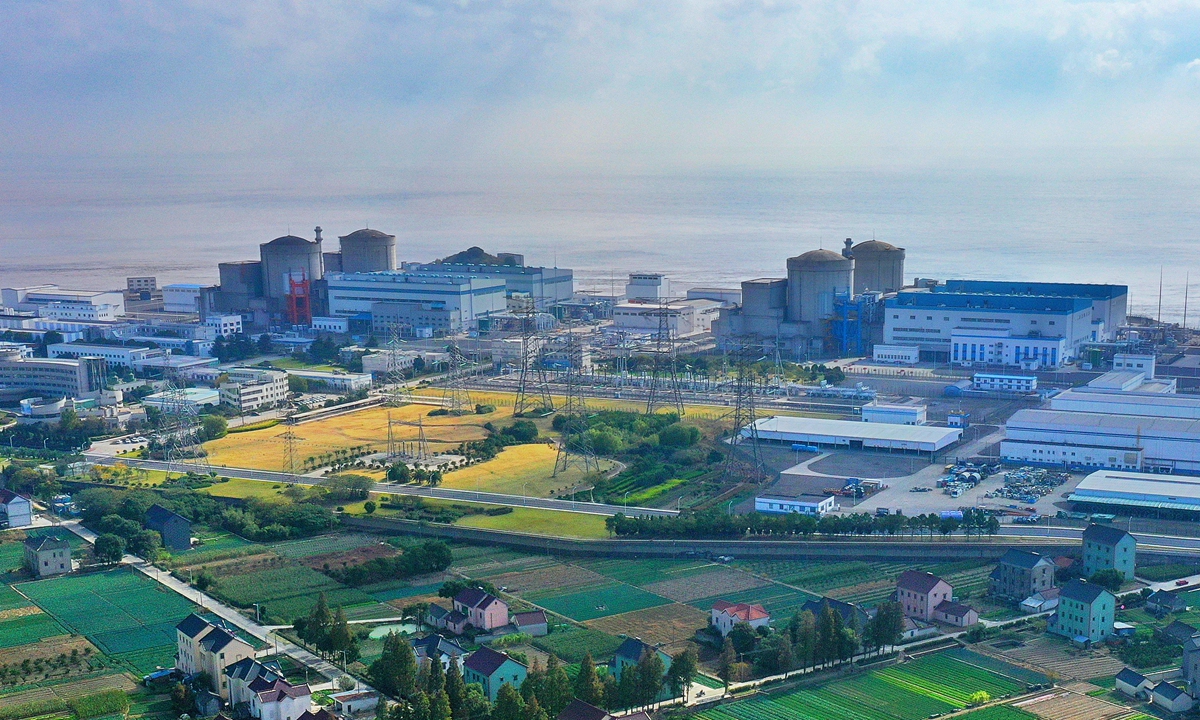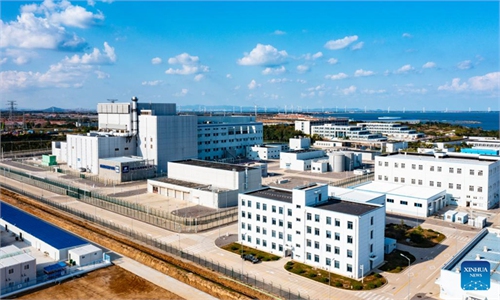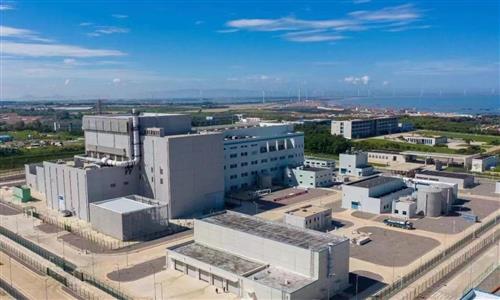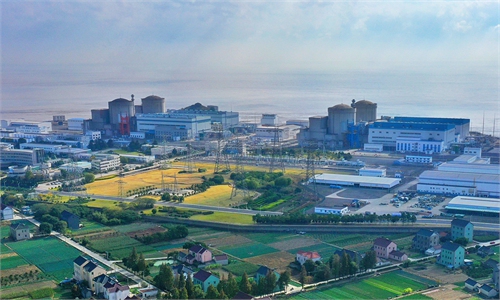
Photo: Courtesy of China National Nuclear Corporation
The average capacity factor of the nine nuclear power units at the Qinshan nuclear power base in East China's Zhejiang Province reached 96.8 percent in 2023, the Global Times learned from China National Nuclear Corp (CNNC) on Monday.
This data ranks No.1 among nuclear power bases with six or more units globally, compared with the data released by the World Association of Nuclear Operators (WANO), setting a new record for the safe and stable operation of similar bases, the CNNC said. Experts told the Global Times that this data shows that China's nuclear power units have comprehensive management capabilities at an international level. '
Outstanding achievements
Capacity factor is one of the important indicators recognized by the international nuclear power industry to evaluate the level of safety management and measure the safe power generation of nuclear units. The capacity factor of a unit is the ratio of the actual power generation it obtained during a certain period to the reference power generation that it should achieve according to design specifications.
"The capacity factor of a unit is used to measure the availability of a nuclear power plant unit, to monitor whether the nuclear power plant can maintain the high reliability, and to reflect the management capability of the nuclear power plant in optimizing planned maintenance activities and reducing unplanned power generation losses," Sun Chao, a deputy director of the production planning department for Qinshan nuclear power base, told the Global Times.
Sun said that the outstanding achievements of the Qinshan nuclear power base were mainly attributed to the improvement of fuel cycle and maintenance planning for the nine nuclear power units, optimization of planned maintenance shutdown activities, and reduction of planned power generation losses.
The Qinshan base also has strengthened testing and inspection of equipment to minimize risks, reduce unplanned power generation losses and enhanced the lifecycle management of equipment. In terms of personnel management, efforts have been made to prevent human errors and improve the level of operational decision-making and risk control, according to Sun.
Nuclear power plants usually carry out routine major maintenance activities for the replacement of nuclear fuel components, necessary inspections and tests, as well as preventive and corrective maintenance of nuclear power units.
During major maintenance periods, the reactor of the nuclear power unit will be shut down. To ensure safety, efforts are made to improve the efficiency of the maintenance and reduce the overall construction period in order to enhance the operational efficiency of the power plant.
Wang Wei, director of the major maintenance management office for Qinshan nuclear power base, told the Global Times that, for a million-kilowatt nuclear power unit, if major maintenance work is completed and connected to the grid one day ahead of schedule while ensuring safety, the power plant can generate an additional 25 million kilowatt-hours of electricity, and the capacity factor of a single unit can be increased by 0.27 percent.
Comprehensive efforts
To ensure high-quality major maintenance, the CNNC proposed the "90-30-00" goal in 2011, which means a capacity factor exceeding 90 percent, an annual construction period of 30 days, and no unplanned-stop period between two major maintenance periods.
"After more than 10 years of efforts, including the mature application of excellent construction period iteration and nuclear power digitalized one-stop major maintenance management methods, the annual construction period of Qinshan nuclear power plant has set a new benchmark for the industry. The safety and quality control of the 2023 major maintenance at the plant base was well-established," Wang said.
Enhancing the safety of nuclear power unit operation is also key to high-level operation and high-quality development of nuclear power plants. In recent years, safety accidents and factors such as wars have caused ups and downs in the global nuclear energy industry. However, China's nuclear energy technology and facilities have developed smoothly, thanks to China's insistence on the dual emphasis on development and safety in nuclear security, ensuring the development of the nuclear energy industry on the premise of safety. Chinese nuclear power plants have achieved a strong and consistent safety record.
"Qinshan base has always attached great importance to safety production, comprehensively building a dual-prevention mechanism for safety risk classification control and hidden danger investigation and governance, improving the risk prevention and resolution mechanism, and continuously improving the level of safety production," Zhao Bing, a deputy director of the facility's safety and quality department , told the Global Times.
According to Zhao, the base has carried out detailed safety risk identification and classification work, and allocated corresponding control resources based on risk levels. Besides, the base has promoted the standardization of hidden danger investigation and governance, using 37 types of safety inspection checklists in six categories, conducting grid-based and full-coverage hidden danger investigation through 100 inspection routes, effectively ensuring the depth and breadth of the investigation.
Qinshan nuclear power base has implemented list-based management for various fixed hazards on-site, clearly designates responsible persons on-site, and realizes 24-hour online real-time monitoring of relevant hazards through a visual monitoring system, Zhao said.
"We have also established incentive funds to reward employees who discover significant safety hazards," he noted.
The Qinshan base also attaches great importance to the construction of safety culture. The Global Times learned that whenever a meeting with three or more people is held at the base, the first agenda item is safety awareness and education, where they study cases of safety production.
"One of our maintenance workers once found a small nut on the ground during inspection process, he became concerned at once, and through careful investigation, he found the location where the nut had fallen off and checked for any other loose or dropped nuts at the site. Only with such meticulous attitude can potential faults be nipped in the bud," said Zhang Hongyao, director of nuclear safety department.
Qinshan experience
Emphasizing communication with international peers is also an effective means of improving nuclear safety. The Qinshan base highly values experiences and lessons learned from the operation of foreign nuclear power plants. After the Fukushima nuclear accident in Japan, the base completed 56 improvement projects of high quality, significantly enhancing the safety of the plants. At the same time, they actively share the "Qinshan experience" of safe operation of nuclear power plants with global organizations and counterparts from various countries, aiming to create a community of shared nuclear safety destiny.
"Our successful experience is to try to ensure that all work is within the plan and minimize unplanned disturbances. For example, during major maintenance, every problem is handled with evidence and reference methods. This avoids mistakes or omissions and prevents unexpected results due to deviations in personal behavior. Through meticulous identification and management, all work is carried out step by step," Zhang explained.
Qi Hongchang, CNNC's chief technician, is mainly responsible for the high-risk work for nuclear power unit maintenance and nuclear fuel rod replacement. He told the Global Times that the number of unexpected situations and emergencies he encounters in his daily maintenance work is decreasing, and most of the maintenance work is now carried out according to plan.
"The average capacity factor of the nine nuclear power units at the Qinshan base reached 96.8 percent annually, which is an indication of high safety. If the accident rate and failure rate of the units are high, or the situations requiring disposal are complex, it would not be possible to operate in a stable manner over an extended period, and the value of the capacity factor would naturally decrease significantly," Qi said.
In recent years, the operational performance of the Qinshan nuclear power base has been increasing year by year, with the average capacity factor of the units exceeding 90 percent over seven consecutive years. In the past four years, the base has achieved a perfect score in the WANO comprehensive operational index for its 30 units, and its operational performance has remained stable at internally competitive levels.
To date, the Qinshan base has operated safely for over 160 reactor-years (one reactor operating for one year is counted as one reactor-year), with a cumulative safe power generation of more than 800 billion kilowatt-hours. This is equivalent to reducing carbon dioxide emissions by 740 million tons and afforesting an area the size of 500 West Lakes, Wu Bingquan, a deputy secretary of the Party Committee of the Qinshan Nuclear Power Base, told the Global Times.
The Qinshan base actively practices the concept of "green mountains and clear waters are as valuable as mountains of gold and silver," leveraging the zero-carbon advantages of nuclear power. Annual monitoring results showed that the nuclear power base has not had any perceptible impact on the surrounding environment since its operation, Wu noted.



